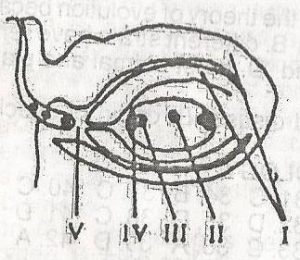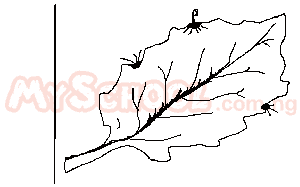
The type of vegetative reproduction illustrated in the diagram above is
- A. grafting
- B. adventitious bud
- C. sucker
- D. aerial layering
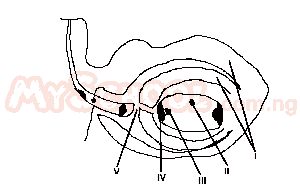
The function of the part labelled V is for the passage of
- A. pollen tube and pollen nucleus
- B. air, water and pollen nucleus
- C. air, antipodal cells and ovum
- D. synergids and egg cell
In which of the following groups of vertebrates would the largest amount of yolk be found in the egg?
- A. Mammals
- B. Fish
- C. Amphibians
- D. Reptiles
The companion cells are part of the
- A. pericycle
- B. phloem
- C. pith
- D. xylem
The appendicular skeleton is composed of the pectoral girdle
- A. pelvic girdle, fore and hind limbs
- B. pelvic girdle and fore limns
- C. lumbar vertebrae and pelvic girdle
- D. lumbar vertebrae, fore and hind limbs
A band of connective tissue linking two bones in a joint is known as
- A. tendon
- B. cartillage
- C. synovial membrane
- D. ligament
The process of deamination is essential for the
- A. digestion of protein
- B. secretion of bile
- C. formation of urea
- D. formation of antibody
Stomatal pores open when there is
- A. an increase in the sugar content of guard cells
- B. a decreases in the osmotic concentration of the guard cell
- C. a decrease in the sugar content of mesophyll cells
- D. an increase in the sugar content of mesophyll cells
Anaerobic respiration differs from aerobic respiration by the production of
- A. less amount of energy and water
- B. greater amount of energy and alcohol
- C. less amount of energy and alcohol
- D. greater amount of energy and water
The element that is essential for the coagulation of blood is
- A. potassium
- B. calcium
- C. phosphorus
- D. iron
Oozing out of water from the leaves of plants in a humid environment is known as
- A. transpiration
- B. osmosis
- C. pinocytosis
- D. guttation
A food substance was treated with a few drops of Sudan III solution and a red coloration was obtained. The food contained
- A. protein
- B. starch
- C. fat
- D. mineral salt
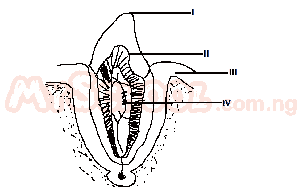
The part labelled I and II constitute the
- A. Crown
- B. neck
- C. root
- D. gum
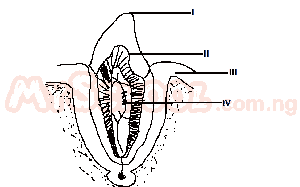
The part that is similar to the bone is labelled
- A. IV
- B. III
- C. II
- D. I
Trace elements are required by plants mainly for the
- A. formation of pigments and enzymes
- B. production of energy and hormones
- C. manufactured of carbohydrates
- D. manufacture of proteins
the part of the stomach nearer the gullet is called th
- A. epiglottis
- B. cardiac spincter
- C. duodenum
- D. pyloric sphincter
In mammals, the exchange of nutrients and metabolic products occurs in the
- A. lymph
- B. lungs
- C. heart
- D. liver
The nitrogenous substance that is excreted by birds in order to conserve water is
- A. ammonia
- B. urea
- C. uric acid
- D. nitric acid
The group of insects that undergoes complete metamorphosis is
- A. houseflies, beetles and cockroaches
- B. cockroaches, grasshoppers and bees
- C. houseflies, beetles and butterflies
- D. aphids, grasshopper and butterflies
In ferns, the sporophyte
- A. develops from a haploid zygote
- B. reproduce asexually to produce spores
- C. is haploid and dependant on gametophyte
- D. is diploid and independent of the gametophyte



